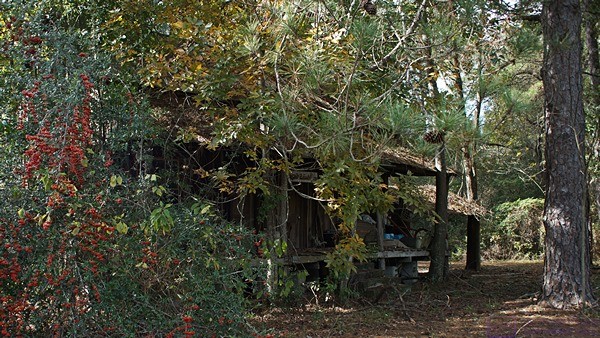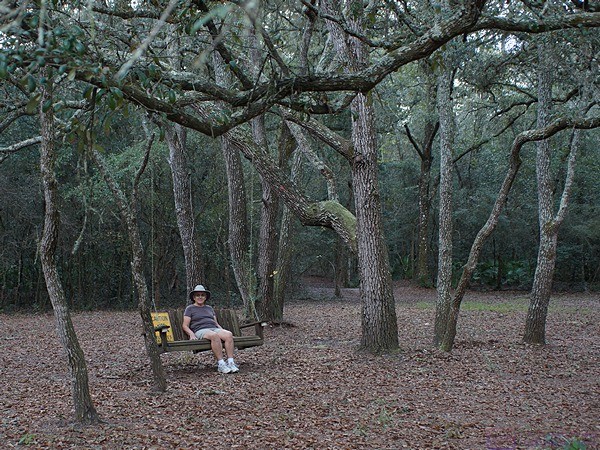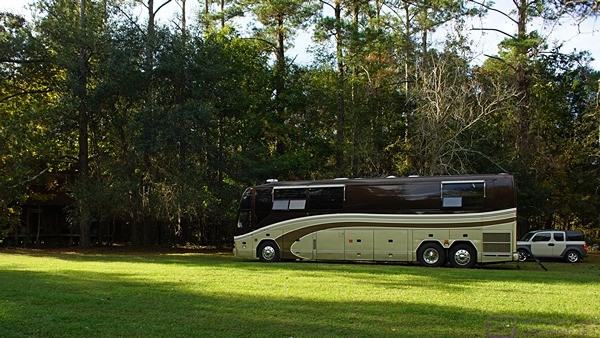I was up at 6:45 AM and wandered over to John’s trailer compound around 7:10. He was outside talking to someone on his cell phone and we finally left at 7:20 for breakfast in Mayo. We went to a small, unassuming diner and waited in the car until Dale showed up. We ordered at the counter, selected ceramic mugs from a basket, and then took a table in the back. I had a version of my usual breakfast out; dry toast with Smucker’s Strawberry Jam and coffee.
We were done by 8:15 and stopped at the NAPA store headed east out of town on US-27. They had a good supply of Group 31 commercial batteries and gave me a good price based on my AITA/NAPA discount card and waved the core charge if I returned the old batteries.
We returned to John’s and I got busy removing the old batteries, which was a bigger project than it sounds. I had to get all four of my tool boxes out plus our Little Giant ladder, nitrile gloves, and paper towels. I also had to disconnect the car from the bus.
The four batteries were lined up, sitting crosswise, in a tray above the passenger side tag axle. Being that far off the ground I found it easier to work from the Little Giant ladder configured as a short step ladder.
My first step was to make a diagram of the physical location of the batteries with the positive and negative terminals marked and lines for the main cables attached to each one. I assigned the numbers 1 through 8 to the terminals and then used green Frog Tape to label each cable with the number of the terminal it was connected to. At Linda’s suggestion I used my iPad to take a photo of the batteries with the labeled cables.
My next step was to remove all of the cables from the batteries, being careful not to allow the exposed lugs on the ends to come in contact with anything they should not touch. Some of the cables were jumpers, which I removed and set aside, while others were captive and had to hang down next to the forward side of the tray. The cables were secured with a lock washer and nut at each terminal which I set aside as I removed them.
With all of the cables removed I proceeded to remove the large nut that secured the retaining bracket that held the batteries and remove it. I started with the battery farthest to the outside as it was the easiest to lift out from atop the ladder. Paul, one of the owners of the Entegra Aspire motorhome parked behind us, had come over to see what I was doing and offered to help. I gladly accepted his assistance and he helped me lift the old batteries out of the tray and get them on the ground. Each one weighs about 80 pounds.
I emptied out part of the driver’s side rear of our Honda Element, loaded the four used batteries in there, and took off for Mayo. The associate at the NAPA store unloaded the old ones for me and loaded the four new ones, which I appreciated. He pulled eight new lock washers for the terminals and a larger one for the hold down bracket, got a 1/8″ brass pipe thread plug, and helped me select at spray lubricant for the tray slides and a grease to coat the connections after they were made to protect them against corrosion.
As best I recall I was back at camp by 9:30 AM and backed the car into position by the passenger side rear of the bus. I used the silicon spray to lubricate the slide tracks. I then moved each battery in turn from the car to the ladder, setting it up one step at a time until I could lift it into the tray and slide it into position. I was careful to use my legs and protect my back muscles.
With the batteries physically in place and oriented correctly I reinstalled the hold down clamp. I then got Linda to help me reattach the cables. I cleaned the ends to remove previous grease and wrapped several of them in electrical tape to ensure they did not short out to the tie down bracket. I put No-Ox electrical connection anti-oxidant on each terminal. We then put the cables back on using the new lock washers and the old nuts. I torqued the nuts tight and we double checked the connections against the diagram. We finished at 12:30 PM, so I felt we had accomplished the battery replacement in a very good amount of time.
I turned on the generator and then turned on the circuit breaker for the maintenance chargers. As I expected the new batteries were not fully charged but the maintenance chargers indicated at least a 75% SOC and we slid the battery tray back in to its compartment. I repacked the tool boxes and Linda loaded them back into the battery bay. We put the ladder back in the front bay and the things I had removed from the car back in there.

This old building seemed to be full of stuff but no longer actively used. Our bus was parked pointing directly at it.
At 1 PM we decided to go for a walk in the woods. I turned off the genset, put on my hiking boots, and got the Sony a99 camera. It was a lovely day for a walk with the air temperature at 80 degrees F but shaded from direct sunlight by the forest. I took a couple of dozen photos along the way. We were back by 2 PM and decided to drive into Mayo to see it and buy some groceries. When we got back we had vegan cold cut sandwiches for lunch and then sat outside for a while. Paul came over to chat followed by Euginia. Doc (the retired veterinarian who owns the property) stopped by and then John drove up to see if we were interested in a campfire. That sounded great so John said he would start one.
We took our chairs over to the fire ring and sat for a long time having a nice conversation. Kathleen arrived in a car and joined the group. We never learned who she was but we did learn that she was there to meet up with folks driving down from Atlanta. On the short walk back to our coach we paused to marvel at the night sky. It is very dark here at night and there were no clouds this evening.
For dinner Linda made linguine with mushrooms, sun-dried tomatoes, garlic, and olive oil. It was very good. She used the induction cooker and we operated off of the batteries/inverter so they got quite a workout. After dinner I used www.antennapoint.com to locate the TV towers around us. I managed to tune in a CBS affiliate so we were able to watch our usual Monday evening TV programs. I worked at my computer off-loading photos from the camera and copying them to the NAS. I e-mailed Butch and texted Chuck regarding the battery replacement.
John suggested that we operate off of the inverter and batteries and run them down to 24.0 VDC which is approximately a 50% SOC, so I agreed to try it. We had issues with the system during the evening. The power was flickering, causing the APC UPS to switch to batteries briefly and the lights to flicker. The TV even turned off once. This has never happened before and I did not know what was causing it, but suspected that we might be using too little power and/or that the inverter had overheated (although I considered that rather unlikely). I ended up turning off the NAS and the Amped Wireless router, which were plugged in to the UPS, and then shut off and unplugged the UPS. My laptop runs on its own battery, of course, but I had already checked my e-mail, off-loaded photos from the camera, and backed up photo files to the NAS, so I turned it off as well.
I also turned off the Search Watts feature on the inverter, which was set to 5 Watts. My understanding is that this feature turns off the inverter when there is no load and turns it back on when a load of at least 5 Watts tries to draw current. Five Watts on a 120 V AC system is 5/120 = 1/24 Amp or slightly more than 40 mA; not very much. On a 24 V DC battery bank the required draw from the batteries, ignoring inverter inefficiency, would be five times that (120/24 = 5) or 200 mA = 0.2 A. The Magnum remote was showing that we were drawing at least 6 A, so that should not have been a problem, but I did not know what else to do and I certainly was not going to bother John at this late hour.
John also suggested that I equalize the batteries and told me how to activate that function on the Magnum 4024 by holding down the button on the unit for at least 25 seconds. The equalizing charge is a 4 hour cycle and he suggested I run it twice, back-to-back once the batteries were fully recharged and the charger was in float mode showing zero Amps. He told me to run the equalizing charge once every six months. I have always read that you should NOT apply an equalizing charge to AGM batteries but John said that the two guys who own Lifeline Batteries now recommend this.
We went to bed a little after 11 PM. Linda fell asleep almost immediately but I was awake until 1 AM working on this post and listening to the sounds of the coach.

